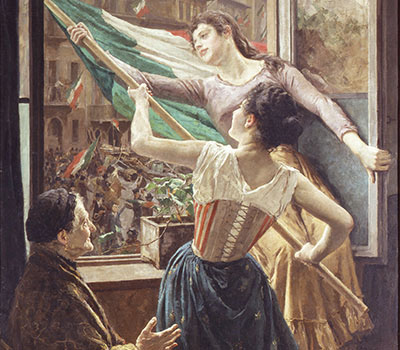Room V-VI-VII - Civic historical collections
Rooms V-VI-VII

The five days of Milan and the First War of Independence
Carlo Stragliati's painting evokes with particular charm the Five Days of Milan, a crucial episode in the Risorgimento and prelude to the First War of Independence. Two young women, looking out of a window, wave the Tricolore, embodying unity feelings and underlining female participation in the revolution. While the works of Gerolamo Induno and Carlo Canella are a faithful chronicle of the ferocious fighting and improvised barricades in the streets of the city. The victory of the insurgents pushed Charles Albert to declare war on Austria.
Even in Rome, in November 1848, a revolt broke out: the liberals demanded a democratic government, social reforms and military support for the Kingdom of Sardinia against the Austrians. Pope Pius IX, who rejected the requests, was forced to abandon the city; the temporal power was temporarily replaced by the nascent Roman Republic, founded on 9 February 1849 and led by Carlo Armellini, Giuseppe Mazzini and Aurelio Saffi, united in the triumvirate. Giuseppe Garibaldi assumed command of the defense of Rome. Gerolamo Induno, a perfect example of a soldier-painter, took part in Roman events and created a series of paintings portraying Garibaldi's legionaries, thus inaugurating a new historical-evocative trend that enjoyed great success in the nineteenth-century artistic panorama. Despite the sacrifice of many patriots, including Luciano Manara who sacrificed his life for freedom, the French army entered Rome on 3 July and re-established the temporal power of the Church. Meanwhile, the battle of Novara on 23 March 1849 marked the definitive defeat of the Kingdom of Sardinia: Carlo Alberto was forced to abdicate in favor of his son Vittorio Emanuele, who signed the peace treaty on 6 August 1849. The revolutionary parenthesis ended and Austria reoccupied Lombardy-Veneto.
There are numerous printed works depicting the martyrs of independence, the political protagonists and the soldiers who participated in the various battles of the Risorgimento, testifying to the documentary value of the printed image and the notable role in celebratory memory and in the formation of a national identity . One of the most interesting iconographic testimonies of the war events that saw the Piedmontese army involved in the main military actions of the two-year period 1848-1849 is the album Campagnes de I'Armeé Piemontaise composed of 35 lithographic plates taken from the drawings of Stanislao Grimaldi del Poggetto commissioned by Alfonso Ferrero de La Marmora, then Minister of War.